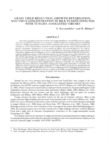Generally, rice plants infected with both rice tungro bacilliform virus (RTBV) and rice tungro spherical virus (RTSV) showed severe symptoms, a market reduction ingrain yield and retardation in growth. RTBV-infected plants showed milder symptoms with a lower yield reduction and growth retardation. RTSV-infected plants showed no clear symptoms and the lowest yield reduction and growth retardation. Irrespective of virus species in plants, the infected plants of the cultivar Balimau Putih showed the lowest yield reduction and growth retardation, followed by plants of the Palasithari, Sigadis, and Utri Rajapan cultivars. Infected plants of the BW 272-6B, FK-135 and TN-1 cultivars displayed a greater yield reduction and growth retardation. Grain yield reduction in the BW 272-6B, FK-135 and TN1 plants infected with both RTBV and RTSV or RTBV alone was greater than 85 % in BW 272-6B, FK-135 and TN1, but less than 20 % in Balimau Putih. The reduction in grain yield in the RTSV-infected plants was as high as 40 % in IR36, about 20 % in IR54 and TN1, and less than 5 % in Balimau Putih, Sigadis and Utri Rajapan. Generally, the yield reduction was higher in the plants infected at 3 weeks after soaking than in the plants infected at 1 to 5 weeks. The reduction was the lowest in the plants infected at 7 weeks. RTBV concentration in doubly infected plants was high in BW 272-6B, IR36 and TN1 but low in Balimau Putih,Jhingasail, Palasithari and Utri Rajapan. RTBV concentration was low in plants with milder symptoms. RTSV concentration was not significantly different among the plants with more severe and milder symptoms.

